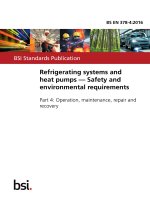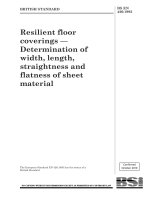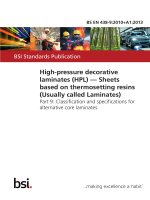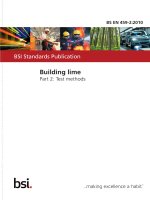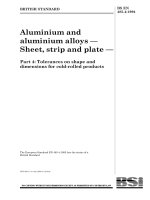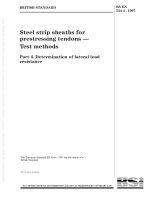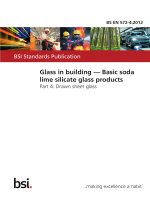Bsi bs en 61508 4 2010
Bạn đang xem bản rút gọn của tài liệu. Xem và tải ngay bản đầy đủ của tài liệu tại đây (398.75 KB, 38 trang )
BS EN 61508-4:2010
BSI Standards Publication
Functional safety of electrical/
electronic/programmable
electronic safety related
systems
Part 4: Definitions and abbreviations
NO COPYING WITHOUT BSI PERMISSION EXCEPT AS PERMITTED BY COPYRIGHT LAW
raising standards worldwide™
BRITISH STANDARD
Licensed Copy: Science & Technology Facilities Council, 25/08/2010 10:14, Uncontrolled Copy, (c) BSI
BS EN 61508-4:2010
National foreword
This British Standard is the UK implementation of EN 61508-4:2010. It is
identical to IEC 61508-4:2010. It supersedes BS EN 61508-4:2002 which is
withdrawn.
The UK participation in its preparation was entrusted by Technical Committee
GEL/65, Measurement and control, to Subcommittee GEL/65/1, System
considerations.
A list of organizations represented on this committee can be obtained on
request to its secretary.
This publication does not purport to include all the necessary provisions of a
contract. Users are responsible for its correct application.
© BSI 2010
ISBN 978 0 580 56236 5
ICS 01.040.25; 01.040.29; 13.260; 25.040.40; 29.020
Compliance with a British Standard cannot confer immunity from
legal obligations.
This British Standard was published under the authority of the Standards
Policy and Strategy Committee on 30 June 2010.
Amendments issued since publication
Amd. No.
Date
Text affected
Licensed Copy: Science & Technology Facilities Council, 25/08/2010 10:14, Uncontrolled Copy, (c) BSI
BS EN 61508-4:2010
EUROPEAN STANDARD
EN 61508-4
NORME EUROPÉENNE
May 2010
EUROPÄISCHE NORM
ICS 25.040.40; 29.020
Supersedes EN 61508-4:2001
English version
Functional safety of electrical/electronic/programmable electronic safetyrelated systems Part 4: Definitions and abbreviations
(IEC 61508-4:2010)
Sécurité fonctionnelle des systèmes
électriques/électroniques/électroniques
programmables relatifs à la sécurité Partie 4: Définitions et abréviations
(CEI 61508-4:2010)
Funktionale Sicherheit sicherheitsbezogener
elektrischer/elektronischer/programmierbarer
elektronischer Systeme Teil 4: Begriffe und Abkürzungen
(IEC 61508-4:2010)
This European Standard was approved by CENELEC on 2010-05-01. CENELEC members are bound to comply
with the CEN/CENELEC Internal Regulations which stipulate the conditions for giving this European Standard
the status of a national standard without any alteration.
Up-to-date lists and bibliographical references concerning such national standards may be obtained on
application to the Central Secretariat or to any CENELEC member.
This European Standard exists in three official versions (English, French, German). A version in any other
language made by translation under the responsibility of a CENELEC member into its own language and notified
to the Central Secretariat has the same status as the official versions.
CENELEC members are the national electrotechnical committees of Austria, Belgium, Bulgaria, Croatia, Cyprus,
the Czech Republic, Denmark, Estonia, Finland, France, Germany, Greece, Hungary, Iceland, Ireland, Italy,
Latvia, Lithuania, Luxembourg, Malta, the Netherlands, Norway, Poland, Portugal, Romania, Slovakia, Slovenia,
Spain, Sweden, Switzerland and the United Kingdom.
CENELEC
European Committee for Electrotechnical Standardization
Comité Européen de Normalisation Electrotechnique
Europäisches Komitee für Elektrotechnische Normung
Management Centre: Avenue Marnix 17, B - 1000 Brussels
© 2010 CENELEC -
All rights of exploitation in any form and by any means reserved worldwide for CENELEC members.
Ref. No. EN 61508-4:2010 E
Licensed Copy: Science & Technology Facilities Council, 25/08/2010 10:14, Uncontrolled Copy, (c) BSI
BS EN 61508-4:2010
EN 61508-4:2010
-2-
Foreword
The text of document 65A/551/FDIS, future edition 2 of IEC 61508-4, prepared by SC 65A, System
aspects, of IEC TC 65, Industrial-process measurement, control and automation, was submitted to the
IEC-CENELEC parallel vote and was approved by CENELEC as EN 61508-4 on 2010-05-01.
This European Standard supersedes EN 61508-4:2001.
It has the status of a basic safety publication according to IEC Guide 104.
Attention is drawn to the possibility that some of the elements of this document may be the subject of
patent rights. CEN and CENELEC shall not be held responsible for identifying any or all such patent
rights.
The following dates were fixed:
– latest date by which the EN has to be implemented
at national level by publication of an identical
national standard or by endorsement
(dop)
2011-02-01
– latest date by which the national standards conflicting
with the EN have to be withdrawn
(dow)
2013-05-01
Annex ZA has been added by CENELEC.
__________
Endorsement notice
The text of the International Standard IEC 61508-4:2010 was approved by CENELEC as a European
Standard without any modification.
In the official version, for Bibliography, the following notes have to be added for the standards indicated:
[1] IEC 61511 series
NOTE Harmonized in EN 61511 series (not modified).
[2] IEC 62061:2005
NOTE Harmonized as EN 62061:2005 (not modified).
[3] IEC 61800-5-2
NOTE Harmonized as EN 61800-5-2.
[4] IEC 61508-5:2010
NOTE Harmonized as EN 61508-5:2010 (not modified).
[5] IEC 61508-6:2010
NOTE Harmonized as EN 61508-6:2010 (not modified).
[6] IEC 61508-7:2010
NOTE Harmonized as EN 61508-7:2010 (not modified).
[8] IEC 61131-3:2003
NOTE Harmonized as EN 61131-3:2003 (not modified).
[10] ISO 8402:1994
NOTE Harmonized as EN ISO 8402:1995 (not modified).
[11] IEC 60601 series
NOTE Harmonized in EN 60601 series (partially modified).
[14] IEC 61508-1:2010
NOTE Harmonized as EN 61508-1:2010 (not modified).
[15] IEC 61508-2:2010
NOTE Harmonized as EN 61508-2:2010 (not modified).
[16] IEC 61508-3:2010
NOTE Harmonized as EN 61508-3:2010 (not modified).
[18] ISO 9000:2005
NOTE Harmonized as EN ISO 9000:2005 (not modified).
__________
BS EN 61508-4:2010
EN 61508-4:2010
Licensed Copy: Science & Technology Facilities Council, 25/08/2010 10:14, Uncontrolled Copy, (c) BSI
-3-
Annex ZA
(normative)
Normative references to international publications
with their corresponding European publications
The following referenced documents are indispensable for the application of this document. For dated
references, only the edition cited applies. For undated references, the latest edition of the referenced
document (including any amendments) applies.
NOTE When an international publication has been modified by common modifications, indicated by (mod), the relevant EN/HD
applies.
Publication
Year
Title
EN/HD
Year
IEC Guide 104
1997
The preparation of safety publications
and the use of basic safety publications and
group safety publications
-
-
ISO/IEC Guide 51
1999
Safety aspects - Guidelines
for their inclusion in standards
-
-
Licensed Copy: Science & Technology Facilities Council, 25/08/2010 10:14, Uncontrolled Copy, (c) BSI
BS EN 61508-4:2010
–2–
61508-4 © IEC:2010
CONTENTS
INTRODUCTION .....................................................................................................................5
1
Scope ...............................................................................................................................7
2
Normative references........................................................................................................9
3
Definitions and abbreviations ............................................................................................9
3.1 Safety terms .......................................................................................................... 10
3.2 Equipment and devices .......................................................................................... 12
3.3 Systems – general aspects .................................................................................... 15
3.4 Systems – safety-related aspects........................................................................... 17
3.5 Safety functions and safety integrity ....................................................................... 19
3.6 Fault, failure and error (see Figure 4)..................................................................... 22
3.7 Lifecycle activities.................................................................................................. 27
3.8 Confirmation of safety measures............................................................................ 28
Bibliography .......................................................................................................................... 32
Index .................................................................................................................................... 33
Figure 1 – Overall framework of the IEC 61508 series .............................................................8
Figure 2 – Programmable electronic system .......................................................................... 16
Figure 3 – Electrical/electronic/programmable electronic system (E/E/PE system) –
structure and terminology ...................................................................................................... 16
Figure 4 – Failure model ....................................................................................................... 23
Table 1 – Abbreviations used in this standard ..........................................................................9
Licensed Copy: Science & Technology Facilities Council, 25/08/2010 10:14, Uncontrolled Copy, (c) BSI
BS EN 61508-4:2010
61508-4 © IEC:2010
–5–
INTRODUCTION
Systems comprised of electrical and/or electronic elements have been used for many years to
perform safety functions in most application sectors. Computer-based systems (generically
referred to as programmable electronic systems) are being used in all application sectors to
perform non-safety functions and, increasingly, to perform safety functions. If computer system
technology is to be effectively and safely exploited, it is essential that those responsible for
making decisions have sufficient guidance on the safety aspects on which to make these
decisions.
This International Standard sets out a generic approach for all safety lifecycle activities for
systems comprised of electrical and/or electronic and/or programmable electronic (E/E/PE)
elements that are used to perform safety functions. This unified approach has been adopted in
order that a rational and consistent technical policy be developed for all electrically-based
safety-related systems. A major objective is to facilitate the development of product and
application sector international standards based on the IEC 61508 series.
NOTE 1 Examples of product and application sector international standards based on the IEC 61508 series are
given in the Bibliography (see references [1], [2] and [3]).
In most situations, safety is achieved by a number of systems which rely on many technologies
(for example mechanical, hydraulic, pneumatic, electrical, electronic, programmable electronic).
Any safety strategy must therefore consider not only all the elements within an individual
system (for example sensors, controlling devices and actuators) but also all the safety-related
systems making up the total combination of safety-related systems. Therefore, while this
International Standard is concerned with E/E/PE safety-related systems, it may also provide a
framework within which safety-related systems based on other technologies may be
considered.
It is recognized that there is a great variety of applications using E/E/PE safety-related systems
in a variety of application sectors and covering a wide range of complexity, hazard and risk
potentials. In any particular application, the required safety measures will be dependent on
many factors specific to the application. This International Standard, by being generic, will
enable such measures to be formulated in future product and application sector international
standards and in revisions of those that already exist.
This International Standard
–
considers all relevant overall, E/E/PE system and software safety lifecycle phases (for
example, from initial concept, though design, implementation, operation and maintenance
to decommissioning) when E/E/PE systems are used to perform safety functions;
–
has been conceived with a rapidly developing technology in mind; the framework is
sufficiently robust and comprehensive to cater for future developments;
–
enables product and application sector international standards, dealing with E/E/PE safetyrelated systems, to be developed; the development of product and application sector
international standards, within the framework of this standard, should lead to a high level of
consistency (for example, of underlying principles, terminology etc.) both within application
sectors and across application sectors; this will have both safety and economic benefits;
–
provides a method for the development of the safety requirements specification necessary
to achieve the required functional safety for E/E/PE safety-related systems;
–
adopts a risk-based approach by which the safety integrity requirements can be
determined;
–
introduces safety integrity levels for specifying the target level of safety integrity for the
safety functions to be implemented by the E/E/PE safety-related systems;
NOTE 2 The standard does not specify the safety integrity level requirements for any safety function, nor does it
mandate how the safety integrity level is determined. Instead it provides a risk-based conceptual framework and
example techniques.
Licensed Copy: Science & Technology Facilities Council, 25/08/2010 10:14, Uncontrolled Copy, (c) BSI
BS EN 61508-4:2010
–6–
61508-4 © IEC:2010
–
sets target failure measures for safety functions carried out by E/E/PE safety-related
systems, which are linked to the safety integrity levels;
–
sets a lower limit on the target failure measures for a safety function carried out by a single
E/E/PE safety-related system. For E/E/PE safety-related systems operating in
–
a low demand mode of operation, the lower limit is set at an average probability of a
dangerous failure on demand of 10 –5 ;
–
a high demand or a continuous mode of operation, the lower limit is set at an average
frequency of a dangerous failure of 10 –9 [h –1 ];
NOTE 3
A single E/E/PE safety-related system does not necessarily mean a single-channel architecture.
NOTE 4 It may be possible to achieve designs of safety-related systems with lower values for the target safety
integrity for non-complex systems, but these limits are considered to represent what can be achieved for relatively
complex systems (for example programmable electronic safety-related systems) at the present time.
–
sets requirements for the avoidance and control of systematic faults, which are based on
experience and judgement from practical experience gained in industry. Even though the
probability of occurrence of systematic failures cannot in general be quantified the standard
does, however, allow a claim to be made, for a specified safety function, that the target
failure measure associated with the safety function can be considered to be achieved if all
the requirements in the standard have been met;
–
introduces systematic capability which applies to an element with respect to its confidence
that the systematic safety integrity meets the requirements of the specified safety integrity
level;
–
adopts a broad range of principles, techniques and measures to achieve functional safety
for E/E/PE safety-related systems, but does not explicitly use the concept of fail safe
However, the concepts of “fail safe” and “inherently safe” principles may be applicable and
adoption of such concepts is acceptable providing the requirements of the relevant clauses
in the standard are met.
Licensed Copy: Science & Technology Facilities Council, 25/08/2010 10:14, Uncontrolled Copy, (c) BSI
BS EN 61508-4:2010
61508-4 © IEC:2010
–7–
FUNCTIONAL SAFETY OF ELECTRICAL/ELECTRONIC/
PROGRAMMABLE ELECTRONIC SAFETY-RELATED SYSTEMS –
Part 4: Definitions and abbreviations
1
Scope
1.1 This part of IEC 61508 contains the definitions and explanation of terms that are used in
parts 1 to 7 of the IEC 61508 series of standards.
1.2 The definitions are grouped under general headings so that related terms can be
understood within the context of each other. However, it should be noted that these headings
are not intended to add meaning to the definitions.
1.3 IEC 61508-1, IEC 61508-2, IEC 61508-3 and IEC 61508-4 are basic safety publications,
although this status does not apply in the context of low complexity E/E/PE safety-related
systems (see 3.4.3 of IEC 61508-4). As basic safety publications, they are intended for use by
technical committees in the preparation of standards in accordance with the principles
contained in IEC Guide 104 and ISO/IEC Guide 51. IEC 61508-1, IEC 61508-2, IEC 61508-3
and IEC 61508-4 are also intended for use as stand-alone publications. The horizontal safety
function of this international standard does not apply to medical equipment in compliance with
the IEC 60601 series.
1.4 One of the responsibilities of a technical committee is, wherever applicable, to make use
of basic safety publications in the preparation of its publications. In this context, the
requirements, test methods or test conditions of this basic safety publication will not apply
unless specifically referred to or included in the publications prepared by those technical
committees.
1.5 Figure 1 shows the overall framework of the IEC 61508 series and indicates the role that
IEC 61508-4 plays in the achievement of functional safety for E/E/PE safety-related systems.
Licensed Copy: Science & Technology Facilities Council, 25/08/2010 10:14, Uncontrolled Copy, (c) BSI
BS EN 61508-4:2010
–8–
61508-4 © IEC:2010
Figure 1 – Overall framework of the IEC 61508 series
Licensed Copy: Science & Technology Facilities Council, 25/08/2010 10:14, Uncontrolled Copy, (c) BSI
BS EN 61508-4:2010
61508-4 © IEC:2010
2
–9–
Normative references
The following referenced documents are indispensable for the application of this document. For
dated references, only the edition cited applies. For undated references, the latest edition of
the referenced document (including any amendments) applies.
IEC Guide 104:1997, The preparation of safety publications and the use of basic safety
publications and group safety publications
ISO/IEC Guide 51:1999, Safety aspects – Guidelines for their inclusion in standards
3
Definitions and abbreviations
For the purposes of this document, the definitions and the abbreviations given in Table 1
below, as well as the following apply.
Table 1 – Abbreviations used in this standard
Abbreviation
ALARP
Full expression
As Low As Reasonably Practicable
Definition and/or explanation
of term
IEC 61508-5, Annex C
ASIC
Application Specific Integrated Circuit
3.2.15
CCF
Common Cause Failure
3.6.10
CPLD
Complex Programmable Logic Device
DC
Diagnostic Coverage
(E)EPLD
(Electrically) Erasable Programmable Logic Device
E/E/PE
Electrical/Electronic/Programmable Electronic
3.2.13, example: E/E/PE
safety-related system
E/E/PE (system)
Electrical/Electronic/Programmable Electronic System
3.3.2
EEPROM
Electrically Erasable Programmable Read-Only Memory
EPROM
Erasable Programmable Read-Only Memory
EUC
Equipment Under Control
FPGA
Field Programmable Gate Array
GAL
Generic Array Logic
HFT
Hardware Fault Tolerance
7.4.4 of IEC 61508-2
MooN
M out of N channel architecture
(for example 1oo2 is 1 out of 2 architecture, where either of
the two channels can perform the safety function)
IEC 61508-6, Annex B
MooND
M out of N channel architecture with Diagnostics
IEC 61508-6, Annex B
MTBF
Mean Time Between Failures
3.6.19, NOTE 3
MTTR
Mean Time To Repair
3.6.21
MRT
Mean Repair Time
3.6.22
PAL
Programmable Array Logic
PE
Programmable Electronic
3.2.12
PE(system)
Programmable Electronic
3.3.1
PFD
Probability of Dangerous Failure on Demand
3.6.17
PFD avg
Average Probability of dangerous Failure on Demand
3.6.18
PFH
Average frequency of dangerous failure [h -1 ]
3.6.19
PLA
Programmable Logic Array
3.8.6
3.2.1
Licensed Copy: Science & Technology Facilities Council, 25/08/2010 10:14, Uncontrolled Copy, (c) BSI
BS EN 61508-4:2010
61508-4 © IEC:2010
– 10 –
Abbreviation
Full expression
PLC
Programmable Logic Controller
PLD
Programmable Logic Device
PLS
Programmable Logic Sequencer
PML
Programmable Macro Logic
RAM
Random Access Memory
Definition and/or explanation
of term
IEC 61508-6, Annex E
ROM
Read-Only Memory
SFF
Safe Failure Fraction
3.6.15
SIL
Safety Integrity Level
3.5.8
VHDL
Very High Speed Integrated Circuit Hardware Description
Language
IEC 61508-2, Annex F, Note 5
3.1
Safety terms
3.1.1
harm
physical injury or damage to the health of people or damage to property or the environment
[ISO/IEC Guide 51:1999, definition 3.3]
3.1.2
hazard
potential source of harm
[ISO/IEC Guide 51:1999, definition 3.5]
NOTE The term includes danger to persons arising within a short time scale (for example, fire and explosion) and
also those that have a long-term effect on a person’s health (for example, release of a toxic substance).
3.1.3
hazardous situation
circumstance in which people, property or the environment are exposed to one or more
hazards
[ISO/IEC Guide 51:1999, definition 3.6, modified]
3.1.4
hazardous event
event that may result in harm
NOTE Whether or not a hazardous event results in harm depends on whether people, property or the environment
are exposed to the consequence of the hazardous event and, in the case of harm to people, whether any such
exposed people can escape the consequences of the event after it has occurred.
3.1.5
harmful event
occurrence in which a hazardous situation or hazardous event results in harm
NOTE
Adapted from ISO/IEC Guide 51, definition 3.4, to allow for a hazardous event.
3.1.6
risk
combination of the probability of occurrence of harm and the severity of that harm
[ISO/IEC Guide 51:1999, definition 3.2]
NOTE
For more discussion on this concept see Annex A of IEC 61508-5.
Licensed Copy: Science & Technology Facilities Council, 25/08/2010 10:14, Uncontrolled Copy, (c) BSI
BS EN 61508-4:2010
61508-4 © IEC:2010
– 11 –
3.1.7
tolerable risk
risk which is accepted in a given context based on the current values of society
[ISO/IEC Guide 51:1999, definition 3.7]
NOTE
See Annex C of IEC 61508-5.
3.1.8
residual risk
risk remaining after protective measures have been taken
[ISO/IEC Guide 51:1999, definition 3.9]
3.1.9
EUC risk
risk arising from the EUC or its interaction with the EUC control system
NOTE 1 The risk in this context is that associated with the specific harmful event in which E/E/PE safety-related
systems and other risk reduction measures are to be used to provide the necessary risk reduction, (i.e. the risk
associated with functional safety).
NOTE 2 The EUC risk is indicated in Figure A.1 of IEC 61508-5. The main purpose of determining the EUC risk is
to establish a reference point for the risk without taking into account E/E/PE safety-related systems and other risk
reduction measures.
NOTE 3
Assessment of this risk will include associated human factor issues.
3.1.10
target risk
risk that is intended to be reached for a specific hazard taking into account the EUC risk
together with the E/E/PE safety-related systems and the other risk reduction measures
3.1.11
safety
freedom from unacceptable risk
[ISO/IEC Guide 51:1999, definition 3.1]
3.1.12
functional safety
part of the overall safety relating to the EUC and the EUC control system that depends on the
correct functioning of the E/E/PE safety-related systems and other risk reduction measures
3.1.13
safe state
state of the EUC when safety is achieved
NOTE In going from a potentially hazardous condition to the final safe state, the EUC may have to go through a
number of intermediate safe states. For some situations a safe state exists only so long as the EUC is continuously
controlled. Such continuous control may be for a short or an indefinite period of time.
3.1.14
reasonably foreseeable misuse
use of a product, process or service in a way not intended by the supplier, but which may result
from readily predictable human behaviour
[ISO/IEC Guide 51:1999, definition 3.14]
Licensed Copy: Science & Technology Facilities Council, 25/08/2010 10:14, Uncontrolled Copy, (c) BSI
BS EN 61508-4:2010
– 12 –
3.2
61508-4 © IEC:2010
Equipment and devices
3.2.1
equipment under control
EUC
equipment, machinery, apparatus or plant used for manufacturing, process, transportation,
medical or other activities
NOTE
The EUC control system is separate and distinct from the EUC.
3.2.2
environment
all relevant parameters that can affect the achievement of functional safety in the specific
application under consideration and in any safety lifecycle phase
NOTE This would include, for example, physical environment, operating environment, legal environment and
maintenance environment.
3.2.3
functional unit
entity of hardware or software, or both, capable of accomplishing a specified purpose
[ISO/IEC 2382-1, 01-01-40]
NOTE In IEV 191-01-01 the more general term “item” is used in place of functional unit. An item may sometimes
include people.
3.2.4
application
task related to the EUC rather than to the E/E/PE system
3.2.5
software
intellectual creation comprising the programs, procedures, data, rules and any associated
documentation pertaining to the operation of a data processing system
NOTE 1
Software is independent of the medium on which it is recorded.
NOTE 2 This definition without Note 1 differs from ISO/IEC 2382-1 (reference [7] in the Bibliography) by the
addition of the word data.
3.2.6
system software
part of the software of a PE system that relates to the functioning of, and services provided by,
the programmable device itself, as opposed to the application software that specifies the
functions that perform a task related to the safety of the EUC
NOTE
Refer to IEC 61508-7 for examples.
3.2.7
application software
application data
configuration data
part of the software of a programmable electronic system that specifies the functions that
perform a task related to the EUC rather than the functioning of, and services provided by the
programmable device itself
3.2.8
pre-existing software
software element which already exists and is not developed specifically for the current project
or safety-related system.
Licensed Copy: Science & Technology Facilities Council, 25/08/2010 10:14, Uncontrolled Copy, (c) BSI
BS EN 61508-4:2010
61508-4 © IEC:2010
– 13 –
NOTE The software could be a commercially available product, or it could have been developed by some
organisation for a previous product or system. Pre-existing software may or may not have been developed in
accordance with the requirements of this standard.
3.2.9
data
information represented in a manner suitable for communication, interpretation, or processing
by computers
NOTE 1 Data may take the form of static information (for example configuration of a set point or a representation
of geographical information) or it may take the form of instructions to specify a sequence of pre-existing functions.
NOTE 2
Refer to IEC 61508-7 for examples.
3.2.10
software on-line support tool
software tool that can directly influence the safety-related system during its run time
3.2.11
software off-line support tool
software tool that supports a phase of the software development lifecycle and that cannot
directly influence the safety-related system during its run time. Software off-line tools may be
divided into the following classes:
–
T1
generates no outputs which can directly or indirectly contribute to the executable code
(including data) of the safety related system;
NOTE 1 T1 examples include: a text editor or a requirements or design support tool with no automatic code
generation capabilities; configuration control tools.
–
T2
supports the test or verification of the design or executable code, where errors in the tool
can fail to reveal defects but cannot directly create errors in the executable software;
NOTE 2
–
T2 examples include: a test harness generator; a test coverage measurement tool; a static analysis tool.
T3
generates outputs which can directly or indirectly contribute to the executable code of the
safety related system.
NOTE 3 T3 examples include: an optimising compiler where the relationship between the source code program
and the generated object code is not obvious; a compiler that incorporates an executable run-time package into the
executable code.
3.2.12
programmable electronic
PE
based on computer technology which may be comprised of hardware, software, and of input
and/or output units
NOTE This term covers microelectronic devices based on one or more central processing units (CPUs) together
with associated memories, etc.
EXAMPLE
The following are all programmable electronic devices:
–
microprocessors;
–
micro-controllers;
–
programmable controllers;
–
application specific integrated circuits (ASICs);
–
programmable logic controllers (PLCs);
–
other computer-based devices (for example smart sensors, transmitters, actuators).
Licensed Copy: Science & Technology Facilities Council, 25/08/2010 10:14, Uncontrolled Copy, (c) BSI
BS EN 61508-4:2010
– 14 –
61508-4 © IEC:2010
3.2.13
electrical/electronic/programmable electronic
E/E/PE
based on electrical (E) and/or electronic (E) and/or programmable electronic (PE) technology
NOTE
The term is intended to cover any and all devices or systems operating on electrical principles.
EXAMPLE
Electrical/electronic/programmable electronic devices include:
–
electro-mechanical devices (electrical);
–
solid-state non-programmable electronic devices (electronic);
–
electronic devices based on computer technology (programmable electronic); see 3.2.12.
3.2.14
limited variability language
software programming language, whose notation is textual or graphical or has characteristics
of both, for commercial and industrial programmable electronic controllers with a range of
capabilities limited to their application
EXAMPLE The following are limited variability languages, from IEC 61131-3 (reference [8] in the Bibliography) and
other sources, which are used to represent the application program for a PLC system:
–
ladder diagram: a graphical language consisting of a series of input symbols (representing behaviour similar to
devices such as normally open and normally closed contacts) interconnected by lines (to indicate the flow of
current) to output symbols (representing behaviour similar to relays);
–
Boolean algebra: a low-level language based on Boolean operators such as AND, OR and NOT with the ability
to add some mnemonic instructions;
–
function block diagram: in addition to Boolean operators, allows the use of more complex functions such as data
transfer file, block transfer read/write, shift register and sequencer instructions;
–
sequential function chart: a graphical representation of a sequential program consisting of interconnected steps,
actions and directed links with transition conditions.
3.2.15
application specific integrated circuit
ASIC
integrated circuit designed and manufactured for specific function, where its functionality is
defined by the product developer
NOTE
–
The term ASIC as a stand-alone covers all types of the following integrated circuits:
Full custom ASIC: ASIC where design and production is similar to a standard integrated circuit with the
functionality defined by the product developer.
A standard integrated circuit is manufactured in large quantities and can be used for different applications.
Functionality, validation, production and production test are solely in the hand of the semiconductor vendor.
Manual manipulations and optimisations at layout level are frequently used to reduce required area. They are
not designed for safety-related systems. Frequent changes in production process, process technology and
layout are likely for cost and yield optimisation. The number of components manufactured using a certain
process or mask revision are not publicly known.
–
Core based ASIC: ASIC based on a pre-layout, designed or generated macro cores, supported by additional
logic.
EXAMPLE 1 Examples for pre-layout macros are standard microprocessor cores, peripheral components,
communication interfaces, analogue blocks, special function I/O cells.
EXAMPLE 2 Examples for pre-designed macros known as Intellectual Property (IP) are a variety of similar
components as mentioned in Example 1, with the difference that the design data consists of a high level
hardware description language (VHDL, Verilog) as described for cell based ASIC.
EXAMPLE 3 Examples for generated macros include embedded RAM, ROM, EEPROM or FLASH (flash
memory). Generated blocks are assumed to be correct by construction, based on design rules. Pre-layout or
generated macros are process specific but may be ported to different technologies. In most cases, the macro
cores are not identical to the original discrete off-the-shelf components (different process, provided by a third
party).
–
Cell based ASIC: ASIC based on logic primitives (like AND, OR, Flip-Flop, Latch) taken from a cell library.
The gate-level netlist containing the logic primitives and the interconnections is usually created from a high
level hardware description language (VHDL, Verilog HDL) using synthesis tools. The functional and timing
Licensed Copy: Science & Technology Facilities Council, 25/08/2010 10:14, Uncontrolled Copy, (c) BSI
BS EN 61508-4:2010
61508-4 © IEC:2010
– 15 –
characteristics of the logic primitives is characterised in the cell library; these parameters are used to drive the
synthesis tool and are also used for simulation. In addition, layout tools are used to place the cells and to route
the interconnects.
–
Gate array: pre-manufactured silicon masters with a fixed number of cells that provide a common starting point
for different components.
The functionality is defined by the interconnection matrix (metal layer) between the pre-manufactured cells. The
design process is very similar to that of a cell based ASIC, while the layout step is replaced by a routing step to
connect the already existing cells.
–
Field programmable gate array (FPGA): standard integrated circuit, using one-time programmable or reprogrammable elements to define the connection between functional blocks and to configure the functionality of
the individual blocks.
It is not possible to test one-time programmable FPGAs completely during production due to the nature of the
programmable element.
–
Programmable logic device (PLD): standard integrated circuit, with low to medium complexity, using one-time
programmable or electrical erasable elements (fuses) to define combinatorial logic – typically based on AND or
OR product terms – and configurable storage elements.
PLDs provide predictable timing and guaranteed maximum operating frequency in synchronous design due to
their regular structure.
Type of PLD are for example PAL, GAL, PML, (E)EPLD, PLA, PLS.
–
Complex programmable logic device (CPLD): multiple PLD-like blocks on a single chip, connected by a
programmable interconnection matrix (crossbar).
The programmable logic element is re-programmable (EPROM or EEPROM) in most cases.
3.3
Systems – general aspects
3.3.1
programmable electronic system
PE system
system for control, protection or monitoring based on one or more programmable electronic
devices, including all elements of the system such as power supplies, sensors and other input
devices, data highways and other communication paths, and actuators and other output
devices (see Figure 2)
NOTE The structure of a PES is shown in Figure 2 a). Figure 2 b) illustrates the way in which a PES is represented in this International Standard, with the programmable electronics shown as a unit distinct from sensors and
actuators on the EUC and their interfaces, but the programmable electronics could exist at several places in the
PES. Figure 2 c) illustrates a PES with two discrete units of programmable electronics. Figure 2 d) illustrates a PES
with dual programmable electronics (i.e. two-channel), but with a single sensor and a single actuator
Licensed Copy: Science & Technology Facilities Council, 25/08/2010 10:14, Uncontrolled Copy, (c) BSI
BS EN 61508-4:2010
61508-4 © IEC:2010
– 16 –
Input interfaces
A-D co nverters
Commun ications
Output in terfaces
D-A converters
Extent of E/E/PE
system
Programmable
Electronics (PE)
(see note)
Input devices
(fo r example sen sors)
Outp ut devices/final elements
(fo r example actuators)
a) Basic PES structure
PE 1
PE
PE
PE 1
PE 2
PE2
b) Single PE system with single
c) Single PE element with du al
mable electron ic devices lin ked in a
mable electr onic device (i.e. one PE
element co mprised of a single channel serial manner (fo r example intelligent
programmable electronics)
sensor and programmable controller)
d) Sing le PE with dual programmable electro nic devices b ut with
sh ared sensors and final elements (i.e.
one PE comprised of two ch annels
of programmable electronics)
IEC 1 657/98
Figure 2 – Programmable electronic system
3.3.2
electrical/electronic/programmable electronic system
E/E/PE system
system for control, protection or monitoring based on one or more electrical/electronic
programmable electronic (E/E/PE) devices, including all elements of the system such as power
supplies, sensors and other input devices, data highways and other communication paths, and
actuators and other output devices (see Figure 3)
Input interfaces
A-D converters
Communications
Extent of
E/E/PE
system
Output interfaces
D-A converters
E/E/PE device
Input devices
(for example sensors)
Output devices/
final elements
(for example actuators)
IEC 1 658/98
NOTE THE E/E/PE device is shown centrally located but such device(s) could exist at several places in the
E/E/PE system.
Figure 3 – Electrical/electronic/programmable electronic system (E/E/PE system) –
structure and terminology
Licensed Copy: Science & Technology Facilities Council, 25/08/2010 10:14, Uncontrolled Copy, (c) BSI
BS EN 61508-4:2010
61508-4 © IEC:2010
– 17 –
3.3.3
EUC control system
system that responds to input signals from the process and/or from an operator and generates
output signals causing the EUC to operate in the desired manner
NOTE
The EUC control system includes input devices and final elements.
3.3.4
architecture
specific configuration of hardware and software elements in a system
3.3.5
software module
construct that consists of procedures and/or data declarations and that can also interact with
other such constructs
3.3.6
channel
element or group of elements that independently implement an element safety function
EXAMPLE A two-channel (or dual-channel) configuration is one with two channels that independently perform the
same function.
NOTE The term can be used to describe a complete system, or a portion of a system (for example, sensors or
final elements).
3.3.7
diversity
different means of performing a required function
NOTE
Diversity may be achieved by different physical methods or different design approaches.
3.4
Systems – safety-related aspects
3.4.1
safety-related system
designated system that both
–
implements the required safety functions necessary to achieve or maintain a safe state for
the EUC; and
–
is intended to achieve, on its own or with other E/E/PE safety-related systems and other
risk reduction measures, the necessary safety integrity for the required safety functions
NOTE 1 The term refers to those systems, designated as safety-related systems, that are intended to achieve,
together with the other risk reduction measures (see 3.4.2), the necessary risk reduction in order to meet the
required tolerable risk (see 3.1.7). See also Annex A of IEC 61508-5.
NOTE 2 Safety-related systems are designed to prevent the EUC from going into a dangerous state by taking
appropriate action on detection of a condition which may lead to a hazardous event. The failure of a safety-related
system would be included in the events leading to the determined hazard or hazards. Although there may be other
systems having safety functions, it is the safety-related systems that have been designated to achieve, in their own
right, the required tolerable risk. Safety-related systems can broadly be divided into safety-related control systems
and safety-related protection systems.
NOTE 3 Safety-related systems may be an integral part of the EUC control system or may interface with the EUC
by sensors and/or actuators. That is, the required safety integrity level may be achieved by implementing the safety
functions in the EUC control system (and possibly by additional separate and independent systems as well) or the
safety functions may be implemented by separate and independent systems dedicated to safety.
NOTE 4
A safety-related system may
a)
be designed to prevent the hazardous event (i.e. if the safety-related systems perform their safety functions
then no harmful event arises);
b)
be designed to mitigate the effects of the harmful event, thereby reducing the risk by reducing the
consequences;
Licensed Copy: Science & Technology Facilities Council, 25/08/2010 10:14, Uncontrolled Copy, (c) BSI
BS EN 61508-4:2010
– 18 –
c)
61508-4 © IEC:2010
be designed to achieve a combination of a) and b).
NOTE 5 A person can be part of a safety-related system. For example, a person could receive information from a
programmable electronic device and perform a safety action based on this information, or perform a safety action
through a programmable electronic device.
NOTE 6 A safety-related system includes all the hardware, software and supporting services (for example, power
supplies) necessary to carry out the specified safety function (sensors, other input devices, final elements
(actuators) and other output devices are therefore included in the safety-related system).
NOTE 7 A safety-related system may be based on a wide range of technologies including electrical, electronic,
programmable electronic, hydraulic and pneumatic.
3.4.2
other risk reduction measure
measure to reduce or mitigate risk that is separate and distinct from, and does not use, E/E/PE
safety-related systems
EXAMPLE
A relief valve is an other risk reduction measure.
3.4.3
low complexity E/E/PE safety-related system
E/E/PE safety-related system (see 3.2.13 and 3.4.1), in which
–
the failure modes of each individual component are well defined;
–
the behaviour of the system under fault conditions can be completely determined.
NOTE
Behaviour of the system under fault conditions may be determined by analytical and/or test methods.
EXAMPLE A system comprising one or more limit switches, operating, possibly via interposing electro-mechanical
relays, one or more contactors to de-energise an electric motor is a low-complexity E/E/PE safety-related system.
3.4.4
subsystem
entity of the top-level architectural design of a safety-related system where a dangerous failure
according to 3.6.7 (a) of the subsystem results in dangerous failure of a safety function
according to 3.6.7 (a)
3.4.5
element
part of a subsystem comprising a single component or any group of components that performs
one or more element safety functions.
[IEC 62061, definition 3.2.6, modified]
NOTE 1
An element may comprise hardware and/or software.
NOTE 2
A typical element is a sensor, programmable controller or final element
3.4.6
redundancy
the existence of more than one means for performing a required function or for representing
information.
[based on IEC 62059-11]
EXAMPLE
Duplicated functional components and the addition of parity bits are both instances of redundancy.
NOTE 1 Redundancy is used primarily to improve reliability (probability of functioning properly over a given period
of time) or availability (probability of functioning at given instant). It may also be used in order to minimize spurious
actions through architectures such as 2oo3.
NOTE 2
The definition in IEV 191-15-01 is less complete.
